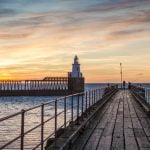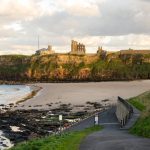The port city of Plymouth has a rich maritime history based on fishing, imports/exports, and a long and continuing association with the Royal Navy. It’s situated on the south coast of Devon in south-west England on the approach to the English Channel. The city lies approximately 37 miles (60 km) south-west of Exeter and 190 miles (310 km) south-west of London. The city is bounded by the River Plym and the River Tamar, the latter of which forms much of the boundary with the neighbouring county of Cornwall. Plymouth is arguably most famous for being the birthplace of Elizabethan naval hero and explorer, Sir Francis Drake. And, as the starting point from which the Pilgrim Fathers set out on their voyage to the new world in the 17th century. The population of Plymouth recorded during the last official UK census in 2011 was 256,384.
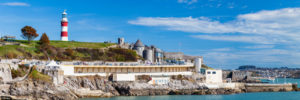
Panoramic view of Plymouth Hoe and the reconstructed 18th-century Smeeton’s Tower lighthouse
A Fleeting History
Plymouth’s earliest history dates back to the Bronze Age with the development of a settlement at Mount Batten. The settlement flourished, becoming a trading post during the times of Roman occupation. However, the real story of Plymouth starts back in Anglo-Saxon times. By the time of the Domesday Book of 1086, the small peninsula known as Sudtone (meaning South Farm), situated at the mouth of the River Plym, was a thriving fishing community. The village continued to develop in unison with Sutton Harbour, becoming a medieval hub for the local area. By the early 13th century, a market had been established, helping turn the village into a small town. In 1254, the Prior of Plympton was granted a market charter for Plymouth. It was sometime after that the town began to develop a reputation as both an important maritime and military location.
By the end of the Middle Ages fishing was the most important industry in Plymouth. Many other goods such as wine, fruit, sugar, and paper were imported from France and Spain. Hemp for rope making was imported from the Baltic region and hops were brought in from Holland. At the same time, wool and tin were exported from Plymouth. There was also internal maritime trade, with coal being shipped from Newcastle and grain from the East of England
Sir Francis Drake
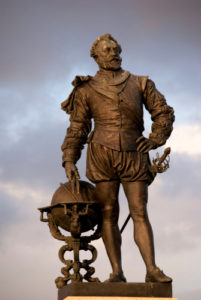
Statue of naval hero Sir Francis Drake in Plymouth
In 1572, Sir Francis Drake set out from Plymouth to become the first Englishman to reach the Pacific. And in 1577, he similarly embarked on the first-ever circumnavigation of the globe. In 1585, Drake sailed to the West Indies and the coast of Florida where he plundered Spanish cities. On his return voyage, he picked up the failed colonists of Roanoke Island, just off the coast of the Carolinas, who had attempted to establish the first English colony in the New World. In 1588, according to popular legend, Drake played bowls on Plymouth Hoe as the invading Spanish Armada sailed up the English Channel. However, despite his alleged apathy and the overwhelming naval superiority of the Spanish, Drake still managed to pull off a spectacular victory. In 1590, Drake built a duct to bring water to the 5,000 strong population of Plymouth. In 1596, he met his end following a bout of dysentery in Panama.
In 1620, the Pilgrim Fathers, persecuted in England for their Puritan beliefs, set sail from Plymouth for the New World on board the Mayflower. They eventually establish a new Plymouth and the first successful English community in what is now the United States of America.
In 1642, at the outbreak of the English civil war, Plymouth’s 7000+ inhabitants sided with parliament, while most of the rest of south-west England supported the king. Realizing the town was exposed to attack, the residents fortified the town. Defences were backed up by parliamentary reinforcements, with up to 9,000 soldiers eventually being stationed there. In August 1643, the royalists laid siege to the town but failed to take it. In January 1646, the royalists were forced to withdraw, as the civil war drew to a close.
In 1670, Plymouth’s military credentials were enhanced when a fortress was built on the Hoe (high ground), which overlooked the town’s coastline. In 1690, the town’s first naval dockyard opened on the banks of the Tamar just to the west of Plymouth. Further docks were built in 1727, 1762 and 1793, establishing Plymouth as the country’s premier naval town. In 1768, adventurer Captain James Cook sailed from Plymouth on the first of his voyages to the Pacific.
Nineteenth Century Plymouth
Throughout the nineteenth century, the population and town boundaries increased dramatically. In 1824, the Plymouth Dock area was renamed Devonport. In 1831, world-famous naturalist Charles Darwin sailed from Plymouth for the Galapagos Islands, where he went on to formulated his revolutionary theories of natural selection and the Origins of Species. Improvements to transport came to Plymouth in 1832 when horse-drawn buses began to run around town. In 1848, the national railway network reached Plymouth. In 1872, the town saw its first horse-drawn trams, and, in 1899, the first electric trams appeared.
Throughout the Industrial Revolution, Plymouth saw continued growth as a commercial shipping port, handling imports and exporting locally mined materials, such as tin, copper, lime, china clay and arsenic. During this time, the neighbouring town of Devonport developed into a strategic Royal Naval stronghold, providing shipbuilding and dockyard facilities. By 1901, Plymouth had an approximate population of 107,000, Devonport had almost 64,000 and Stonehouse 15,000. In 1914, the neighbouring towns of Plymouth, Devonport and East Stonehouse were merged to form the single Borough of Plymouth. In 1928, Plymouth was granted city status, with some 5,000 housing units being built between the wars. In 1938, the city’s northern boundaries were redrawn, adding to the population.
During World War Two, the city’s naval importance led to Plymouth being heavily targeted by the German Luftwaffe, which led to much devastation. As early as 1943 a revolutionary plan was drawn up to rebuild the city. In the 1940s, 1950s and 1960s a spate of council houses was built to bolster the city’s supply of available accommodation. By 1951, the plan to rebuild the city centre was well underway.
The Modern Era
In 1961, the Tamar Bridge opened, greatly improving the city’s connectivity. In 1962, the Civic Centre was built, and, in 1963, the new Law Courts. In 1967, the subsequent expansion of Plymouth’s boundaries led to the incorporation of Plympton and Plymstock into the city’s borough. In 1973, Ocean Quay marina opened and ferries began running between Plymouth and Brittany, France. And in 1978, a service to Santander in Spain was initiated. A new Central Library was built in 1978, new magistrates courts in 1979, and the General Hospital in 1981. The 1980s and 1990s saw a number of other important buildings erected within the city.
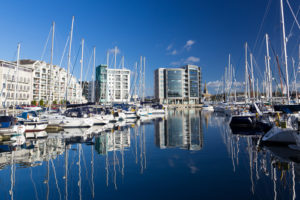
Plymouth Marina and Barbican area
Today, Plymouth’s economy remains strongly influenced by shipbuilding and seafaring, having the largest operational naval base in Western Europe in HMNB Devonport. Fishing has also remained an important industry to Plymouth. And, although shipbuilding at Plymouth dockyard ended in 1968, a new fleet maintenance base was opened in 1978, and a new submarine refit complex opened in 1980.
Tourism is now also an important industry for the city. The Barbican and Plymouth Hoe, which have been greatly refurbished in relatively recent times, are a particular draw for visitors. The city is also able to cash in on the fact that it has of the world’s best and most picturesque natural harbours in ‘Plymouth Sound’.
Getting there!
By road
Travelling by car to Plymouth is easily accessible from most locations within the UK. The motorway network will take you onto the M5, which eventually becomes the A38 taking you directly to Plymouth. Drive time from London is around 4 hours and about 4.5 hours from Manchester.
By bus
If you’re travelling from within the South West region the Stagecoach Falcon service connects Plymouth with Exeter, Taunton and Bristol. National Express run up to 14 coaches per day from London Victoria Coach Station.
By train
The average journey time between London and Plymouth is around 3.75 hours. On any ordinary weekday, there are more than 40 trains travelling in each direction between London and Plymouth. Journey times are generally a little longer on weekends and holidays.
By Air
Bristol has the nearest main airport to Plymouth. Stagecoach Falcon operates a bus service between the two destinations. The journey time for the 110 miles distance is usually a little over 3 hours. It’s a direct service and there are usually 18 buses per day.
Things to see and do!
Plymouth is a lively seafront city, steeped in maritime history, with one of the world’s best natural harbours. There’s plenty of attractions, sightseeing and activities, to see and do, along with loads of great shopping and entertainment. A suggestion of some of the many places to see are:
- The Barbican – a labyrinth of narrow lanes with more than a hundred 16th, 17th and 18th century listed buildings.
- Plymouth Hoe – viewpoint over ‘The Sound’, a fantastic natural harbour.
- Smeaton’s Tower – a mid-18th century reconstructed lighthouse on the Hoe.
- National Marine Aquarium – has over 400 species and over 4,000 individual animals
- Saltram House – a Georgian mansion, set in 500 acres of farmland, comprising of woods, marshes and farmland that includes the Plym estuary.
- Plymouth Gin Distillery – aka Black Friars Distillery, is a functional building that still produces the world-famous Plymouth Gin. Some of the architecture dates back to 1431.
- The Royal Citadel – 18th-century military stronghold still controlled by the Army. Guided two-hour tours on Mondays, Tuesdays, Thursdays and Sundays from April to September.
- Plymouth War Memorial – bears the names of more than 23,000 naval personnel of the 1st & 2nd world wars who have no known grave. The Grade I listed, 1924 obelisk stands on the Hoe.
- Wembury – 15 minutes from Plymouth, an Area of Outstanding Natural Beauty, that sits on the coast near the small village of Wembury.
- Devonport Naval Heritage Centre – largest naval base in Western Europe with maritime artefacts dating back to the 14th century.
Famous Sons
Some of the most celebrated people born in Plymouth include:
Sir Francis Drake 1540 – 1596 Naval commander, Adventurer and Explorer
Robert Falcon Scott 1868 – 1912 Antarctic Explorer
William Bligh 1754 – 1817 Naval Officer and Colonial Administrator
Richard Greene 1918 – 1985 Well-known Film and TV actor
Did you know?
Plymouth Gin Distillery, opened in 1793, is the oldest working distillery in England
William Cookworthy started the British porcelain industry in Plymouth in 1768
‘Janner’ is a common term used to describe people from the Plymouth area, especially in naval circles. It’s based on the local pronunciation of ‘‘John’’.
Where to stay?
There’s a good choice of accommodation in and around Plymouth with prices to suit all budgets. However, the supply of holiday-let style accommodation at the top end of the overall price range for a stay by two people tends to dominate the market. This type of accommodation tends to sleep 4 to 6 people, so they work out much cheaper for a group. A broad indication of nightly rates for the different types of available accommodation are:
Guesthouse/B & B/Lodge: £40 – £60
Standard Hotel: £60 – £100
3/4/5-Star Hotel: £100 – £200
Holiday Let/Apartment: £100 – £200 (2 – 6 people)



